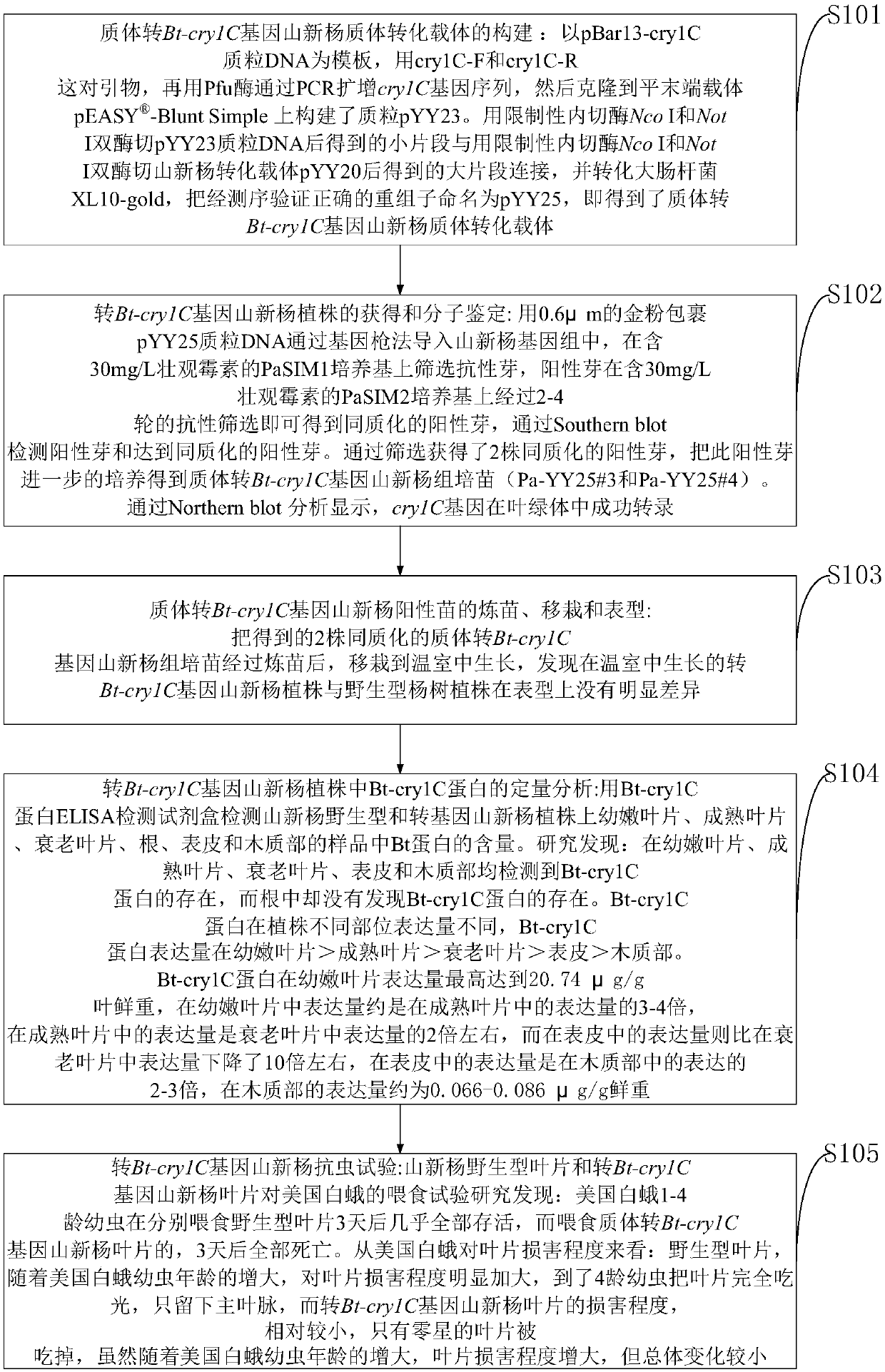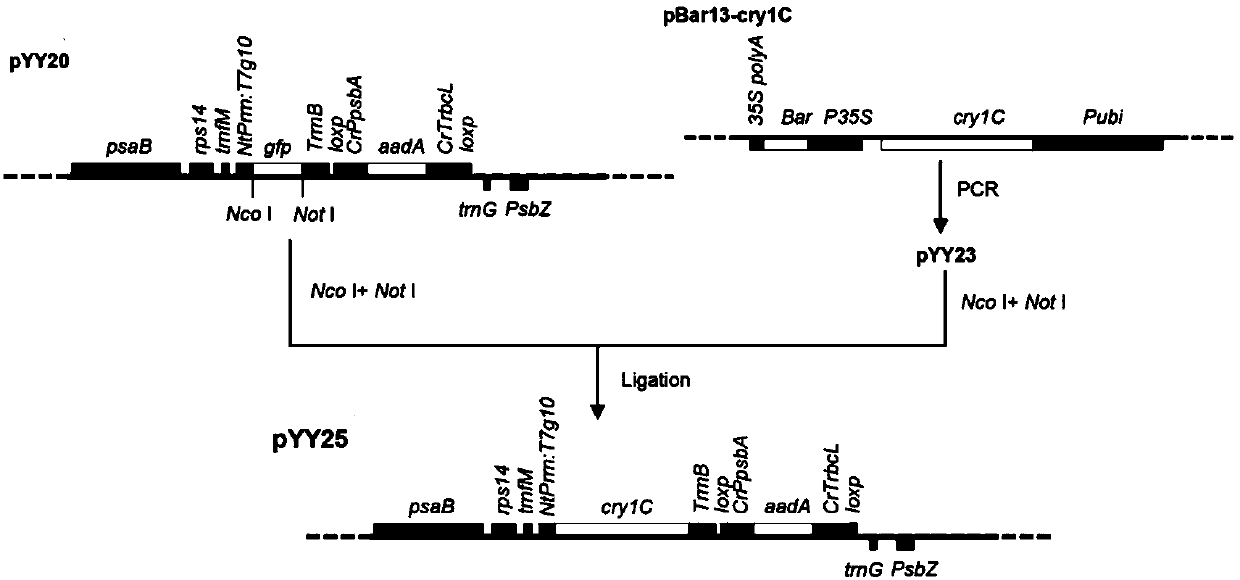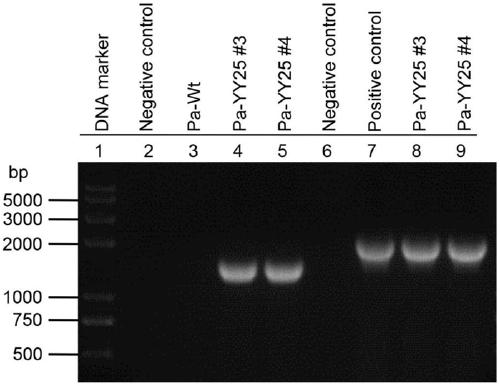Method for obtaining new variety of high-resistance white moth plasmid transgenic Bt poplar
A new variety and gene technology, applied in the field of obtaining new poplar varieties with high resistance to white moth plastid transgenic Bt gene, can solve the problems of gene integration site uncertainty, unstable expression, gene escape, etc.
- Summary
- Abstract
- Description
- Claims
- Application Information
AI Technical Summary
Problems solved by technology
Method used
Image
Examples
Embodiment 1
[0062] The construction of the plastid transformation vector of Bt-cry1C gene Populus montana:
[0063] Using pBar13-cry1C plasmid DNA as a template,
[0064] Use cry1C-F (5'GCGGCCGCCTACTTTTGTGCTCTTTCAAGGTCAGATT3'SEQ ID NO: 2) and cry1C-R (5'CCATGGAGGAGAACAATCAGAACCAGTG3'SEQ ID NO: 3) this pair of primers, and then use Pfu enzyme to amplify the cry1C gene sequence by PCR. After clean kit purification, with blunt-ended carrier After Simple ligation, transform Escherichia coli XL10-gold, and after the obtained recombination is verified by PCR and enzyme digestion, it is sent to a sequencing company for sequencing verification, and the verified correct recombinant is named pYY23. Digest the pYY23 plasmid DNA with restriction endonucleases Nco I and Not I, and after agarose gel electrophoresis, cut out the small fragments on the corresponding gel, recover them with a gel recovery kit, and extract the small fragments Ligate with the large fragment obtained after double-enzyme cu...
Embodiment 2
[0066] Using gene gun method to introduce pYY25 plasmid DNA into the genome of Populus japonicus and screening of resistant buds:
[0067] The pYY25 plasmid DNA was wrapped with 0.6 μm gold powder, and the poplar leaves were bombarded with a Bio-Rad gene gun (PDS-1000 / He). 9cm), vacuum degree 28. The specific operation was carried out according to the gene gun operation manual, and was carried out with reference to the poplar plastid gene gun transformation method. The leaf material bombarded by the gene gun was cut into a size of 3*3mm, placed on the PaSIM1 selection medium containing 30mg / L spectinomycin with the abaxial side up until resistant buds appeared, on this medium every 1- The culture medium was changed once every February. The screening culture conditions are: 25°C 16h light / 20°C 8h dark, light intensity: 20-25μE·m -2 ·s -1 .
Embodiment 3
[0069] Obtaining and Molecular Identification of Plastid Transgenic Bt-cry1C Gene Populus montana Plants:
[0070] Preliminary identification of the resistant buds of Populus japonicus transfected with Bt-cry1C gene: the leaves of the resistant buds grown on 30mg / L spectinomycin PaSIM2 and the leaves of wild type poplar japonicus cultivated conventionally were taken to extract the total DNA of the leaves as The template was tested by PCR with primers JC-Pa-F (5'GGGTATATCTCTTCTTAAAGTTAAACTGCAGTATTTG3'SEQ ID NO: 4) and JC-Pa-R (5'CGGTACTTGTGATATTTCGGCTTG 3'SEQ ID NO: 5), and it was found that: The control and the wild-type control did not amplify to a band similar to the size of the gene (1903bp), while the transgenic Bt-cry1C gene Pa-YY25#3 strain and Pa-YY25#4 strain were amplified to a band similar to the gene size (1903bp). The similar bands of the gene size (1903bp) indicate that the gene has been transferred into the cells of Populus pubescens; the negative control and the...
PUM
 Login to View More
Login to View More Abstract
Description
Claims
Application Information
 Login to View More
Login to View More - R&D
- Intellectual Property
- Life Sciences
- Materials
- Tech Scout
- Unparalleled Data Quality
- Higher Quality Content
- 60% Fewer Hallucinations
Browse by: Latest US Patents, China's latest patents, Technical Efficacy Thesaurus, Application Domain, Technology Topic, Popular Technical Reports.
© 2025 PatSnap. All rights reserved.Legal|Privacy policy|Modern Slavery Act Transparency Statement|Sitemap|About US| Contact US: help@patsnap.com



